Decorative calla. Decorative callas, growing and caring for them in the garden - these are the issues that we will pay special attention to.
Perhaps the best intermediaries in communication between people are flowers. They accompany us everywhere: they give us moments of joy, emotions, help to express what is not always possible to say in words. A long time ago, back in the Victorian era, the language of flowers was used to secretly express their feelings, when it was forbidden to talk about them openly. Today, the language of flowers, of course, is forgotten. And few people want to delve into its subtleties, considering it all stupid prejudices.
However, there is a flower that causes a lot of controversy: some admire its elegance and grace, others do not even want to see it in their home, considering it a harbinger of death. This flower is a calla. Today we will try to figure out why many people believe that callas are the flowers of death.
African guest
Callas have another name - calla, which they received for their resemblance to the wing of a swan. This flower came to us from distant South Africa, so it is not at all afraid of drought and is quite unpretentious. The calla itself is distinguished by some special simplicity and luxury at the same time: a leaf-blanket wrapping a yellow candle and exuding a delicate aroma of vanilla.
Callas - flowers of death or a sign of happiness?
There is an opinion that calla is a flower of death. Let's try to figure out what it is connected with.
The point is that in some European countries It is customary to bring white flowers to funerals, including calla lilies. Such flowers are planted on the graves of deceased relatives; they are forbidden to be presented to elderly women (as if hinting at an imminent death). In addition, some opponents of these flowers believe that they are more like wax figures than living plants.
However, many florists say that calla is a flower of purity and purity, happiness, marital fidelity. And in the language of flowers we have forgotten, calla means adoration and respect. The giver, as it were, wants to say to the woman: “You are gorgeous!”.
Legends about the origin of callas
There are many legends about the origin of calla lilies that will help us with deciphering the secret meaning of this flower.
![]()
The Legend of the Immaculate Girl
Many centuries ago, a small settlement living deep in the forest was attacked by a strong and vicious tribe. The leader of this tribe was captivated by the beauty of a young rural girl with large beautiful eyes and white skin. He decided to make her his wife at all costs and set a condition: either she would become his forever, or the entire village would be destroyed.
The poor girl had no choice. On the day of the upcoming marriage, she was dressed in a beautiful white outfit and taken to the leader. On the way, the girl saw a fire that was kindled for the ceremony, and decided to throw herself into it. But as soon as she took only one step towards the fire, she froze and turned into a beautiful white flower - calla.
Since then, a girl who did not want to become the wife of an evil leader has been a symbol of purity and purity. This is probably the reason why callas are so popular in bridal bouquets.
It is believed that a bouquet collected from these flowers is able to give the bride marital happiness and mutual love. For a long time, mono-bouquets consisting exclusively of callas were preferred. But florists recommend balancing energetically strong callas with other flowers: roses and orchids.
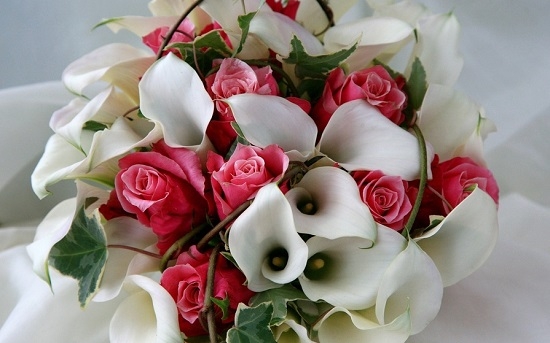


However, there are several restrictions when creating a bridal bouquet from these flowers:
- such bouquets do not go well with lush, frilly dresses;
- a bouquet of callas is not recommended to be overloaded with decorations: the beauty and elegance of this flower speaks for itself.
By the way, the Feng Shui teaching also says that calla bears exclusively positive energy and helps to establish peace and harmony in the family. And if you look closely at the flower, you can see that its petals are heart-shaped.
To finally debunk the myth that calla is the flower of death, I would like to recall another beautiful belief.
The legend of two lovers
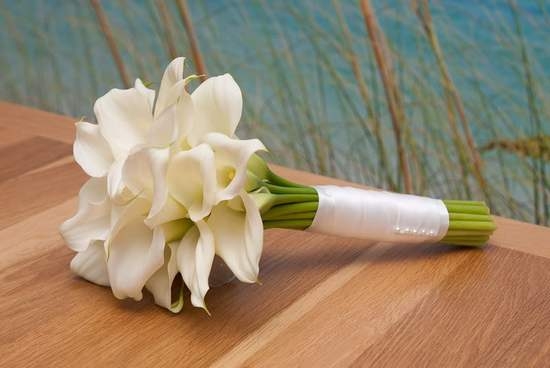
Long ago, when the Gods were still descending to earth, the beautiful and young goddess fell in love with the son of the leader Indian tribe. The lovers began to secretly meet.
However, their serene happiness did not last long: God the father found out about their passion and forbade his daughter to meet with an earthly guy. But the young goddess was rebellious and tried to meet her lover again, for which she was severely punished - her father made her invisible.
The heartbroken girl did not stop coming to her beloved, but the young man could not see her. Then he collected the most beautiful flowers that only grew in the area, and wove them into a light cloak. The young man wanted to throw it on his beloved, because in this way he could see at least the silhouette of the girl.
When the veil of flowers enveloped the girl, she burst into tears, the young man also sobbed bitterly. Their tears melted the father's heart, and he lifted the spell. The thinnest cape of flowers fell to the ground. After a while, the young people got married and were very happy.
And in the place where the cape fell, beautiful snow-white flowers grew, one single petal of which resembled the same cape woven by the young man's loving hands.
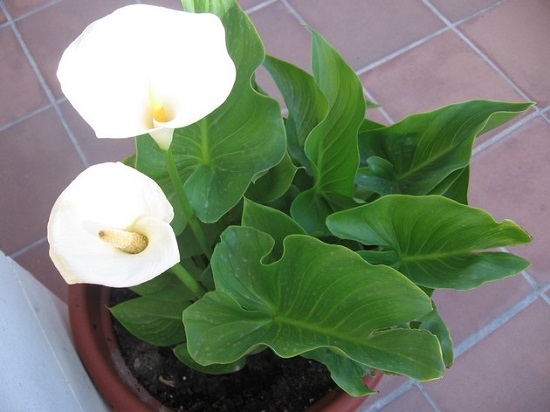
Despite its apparent simplicity, calla is a very difficult flower. The people endow it with magical properties:
- It is believed that not only the flower, but also its image is endowed with special power. So, calla protects the house from the "evil eye", helps to cope with stress and despondency. Be sure to get something in the house with the image of this flower. For example, bed linen or tablecloth.
- Callas are a symbol of endurance and building relationships. It is believed, for example, that if there is no sweetness in a house with children, then it will be useful to put this flower in their room. It will have a beneficial effect on the child and help build mutual understanding.
- It is also believed that calla has a good effect on human health, protects him from all sorts of diseases. By the way, a bouquet of callas, presented to a person suffering from a serious illness, will give him vigor and strengthen hope for a speedy recovery.
- It is recommended to start calla lilies for people who are insecure, timid. They inspire decisive actions, help to bring the most daring ideas to life.
- As a calla plant, it is poisonous, but few people know that a strong antidote for snake bites was made from its rhizome.
Surely every gardener has at least once met callas, which are grown as a potted plant.
Few people thought that you can plant callas in the garden, the main thing is to provide them with proper care.
How to grow callas outdoors
During flowering, callas are quite beautiful. Each peduncle lives for a month.
If you decide to grow callas, then allocate enough space for them. Plants prefer open clearings, but in the heat of the day they need saving shade. It is good if shrubs or trees grow nearby.
The soil for growing callas is selected fertile. Poor in composition, the land is enriched with humus and peat. Before planting, the soil must be drained, as the plants do not tolerate stagnant moisture at the roots.
Among other things, callas have their own characteristics that must be considered when planting:
Rhizomes are planted shallow, barely sprinkled with earth to avoid rotting;
Sprouts appear only after a month, calla lilies build up the root system for a long time;
The tubers of the plant are quite fragile, they must be handled with care.
It is not difficult to grow calla lilies in central Russia, but for the winter the tubers must be dug up and stored in a cold place.
How to plant callas in the garden (photo)
IN open ground plant tubers are planted in the spring, when the threat of frost has passed. autumn planting plants are not included.
As a rule, callas are planted in mid-May, after preparing the tubers.
1. Planting material is kept in a solution of potassium permanganate for 30 minutes.
2. Dry the tubers and cut out all the affected areas, capturing healthy tissue.
3. All sections are treated with brilliant green.
Pickled tubers are planted in a garden bed, which is previously dug up with mineral fertilizers. The depth of planting tubers is about 5-10 cm. Larger bulbs are buried deeper, and small ones are placed almost on the surface of the soil. The distance between plants in the flower bed is made from 30 to 40 cm.
Be patient after planting. Remember that the plant does not sprout for a long time until a good root system is formed. All this time, you do not need to water the garden bed, the moisture that remains after planting will be enough.
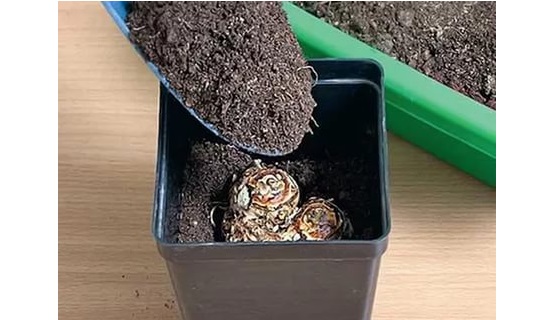
There is another way to plant callas, which is often used by gardeners. In mid-March, the tubers are planted in bowls and watered well. Any flower soil that is sold in stores will do. A month before planting the plants in the flower bed, the pots are taken out into the street for hardening. Calla lilies are transplanted along with an earthen clod, by transshipment.
How to care for calla lilies outdoors
Caring for callas does not cause worries. All the plants need is watering and loose soil.
Water the flowers moderately, but regularly. During the dry season, watering is increased. In addition, after each watering, the soil around the bush is carefully loosened, trying not to damage the roots.
Calla lilies are fertilized only if the soil on the site is poor. Mineral fertilizers are suitable for top dressing, with a solution of which flowers are watered once a month. If, when planting, the holes were filled with fertilizers, then you do not need to additionally feed the callas.
rest period
In the conditions of Russia, callas are grown as an annual plant, since they do not tolerate harsh winters. Therefore, every autumn the tubers are dug up and stored until planting.
After flowering, the tubers are removed from the ground, washed well and dried in a ventilated area. At the same time, they try not to remove the leaves, since during this period the nutrients sink into the tubers. The tubers are dried for about 1.5 weeks, until the leaves themselves dry out and separate from the roots.
After 10-15 days, the tubers are examined, damaged or diseased are removed. For the rest, small roots are cut so that the tubers do not begin to germinate ahead of schedule. If children have formed, then they are left together with the mother plant, without separating them.

Bulbs are stored in a cool room where the temperature does not rise above + 7C. If this condition is not met, then you can forget about the flowering of callas. Many gardeners store tubers in the basement, but it must be dry. It is very important to monitor the humidity of the air so that the plants do not start growing or begin to rot. Regularly inspect the tubers, select suspicious ones.
You can store the rhizomes in the refrigerator on the bottom shelf. Previously, each tuber is wrapped in paper and placed in a bag. The duration of the dormant period is from 1.5 to 2 months.
Calla reproduction
Callas reproduce by babies that form on the roots of the mother plant. They are carefully separated from the tubers and grown in a bowl or in a garden bed.
Up to 30 children can form on one tuber. They are separated and placed in bowls with loose soil. The depth of placement of children is 5-6 cm. Nutrient soil is used, which is pre-mixed with mineral fertilizers.
After the emergence of seedlings, the nodules are seated at a distance of 6-7 cm from each other. In the room where callas are grown, the temperature is maintained at 15-17 degrees. Care for young callas in the same way as for adult plants. Children regularly, but little by little, water, the soil in the pot is loosened.
As soon as the callas grow up and release the second leaf, the plants are fed with complex fertilizers. They must contain nitrogen and potassium. Feeding frequency - 1 time per month. The first year, young plants are grown at room conditions without a dormant period, and the next summer, the tubers are transferred to the standard scheme.
What kind of calla to plant on the site (photo of varieties)
Only three types of callas are involved in breeding new varieties:
Ethiopian;
Remann;
Eliot.
Ethiopian calla is a large rhizomatous plant that does not have a bulb. The height of the peduncle of this plant reaches 1 meter. Ethiopian calla prefers moist soil, it does not have a pronounced dormant period, it does not shed its leaves. Among this variety, the following varieties are most popular:
Green Goddess - plant height about 90 cm, green veil;
Pearls are a low-growing variety that is convenient to grow in pots;
Nikolay - a coverlet of green color, large, up to 12 cm in diameter, peduncle height up to 1.5 meters.

Calla Remann - the height of the plant barely reaches 70 cm. The cover of the peduncle is pale pink with a lilac tint. The underground part is represented by a tuber that resembles a gloxinia tuber. Calla sheds leaves, a dormant period is required for regular flowering. Popular varieties:
Evening - a coverlet of a black-lilac shade;
Indian summer - pomegranate veil;
Chameleon - a cover of a peach-colored peduncle with golden tints.
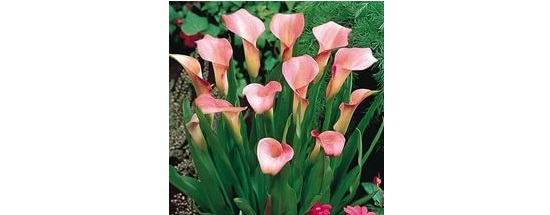
Calla Eliotta - yellow peduncle cover, large. The height of the plant is about 50 cm, the leaves are large, heart-shaped with specks. Varieties:
Vermeer - peduncle cover wavy dark cherry color;
Yellow corner - bright plants, leaves with yellow specks;
Black-eyed beauty - lemon-colored bedspread, speckled leaves.
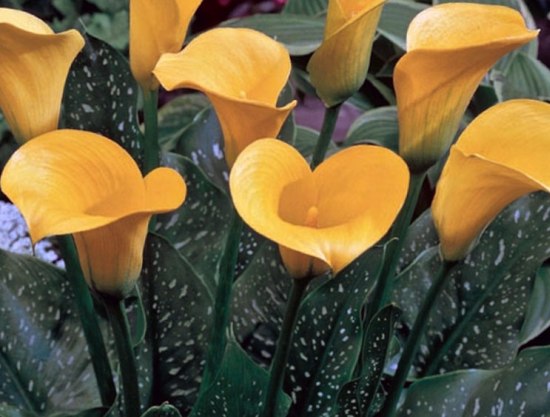
Other types of calla lilies growing in the wild are not suitable for horticultural cultivation.
Calla (popular name marsh calla) belongs to the genus of herbaceous perennials of the Aronnikov (or Aroid) family, which are coastal or wetland plants. Calla Zantedeschia belongs to a separate genus of the same aroid family.
Callas have perhaps the widest distribution range for plants, since they grow in temperate climates throughout the Northern Hemisphere. And this means that calla can be found in South America, and in Africa, and in Eurasia, and even in some zones of the Subarctic.
Callas love very wet places: a swamp, a flooded ditch, a swampy lakeshore - this is their favorite habitat.
Botany. calla or zantedeschia
Botanical description
Calla rhizomes are usually located on the surface of the nutrient substrate. In the internodes of the rhizomes, bundles of adventitious roots are placed.
Glossy and thick leaf blades are equipped with long petioles, have an oval-heart shape and pointed tips. Leaf venation is arcuate: numerous lateral veins, moving away from the central vein, merge in the upper part of the leaf and reach its very end.
True calla flowers are completely inconspicuous: they are devoid of petals, are unisexual and are grouped on a dense inflorescence-cob, surrounded by a spectacular cover leaf - "veil". It is this cover that many take for a flower. The lack of attractiveness is more than redeemed by the wonderful aroma (reminiscent of the aroma of vanilla pods) that true calla flowers exude. A strong smell attracts insects that come to feast on nectar. At the very beginning of flowering, the cover is painted white. After pollination of the flower, the coverlet turns green and takes part in additional photosynthesis. The flowering period of callas is at least three months and falls on May - July.
Four weeks after the cessation of flowering, calla lilies ripen: small ruby-red juicy berries, collected like a cylindrical cob.
How to plant callas in the garden
Planting callas in the garden can be done in two ways:
The tubers are placed in a temporary planter, and then transplanted into open ground. Calla lilies are planted in spring in the last decade of March or in the first week of April. The planting depth should not exceed a couple of centimeters. The substrate for planting can be bought at the store (the one used for ordinary seedlings is quite suitable). You can bring soil from the street, after sterilizing it in the oven for forty minutes. If necessary, peat is added to the prepared substrate. It is not necessary to fertilize the planted tubers. Watering frequency should be limited to a couple of times a week. Before planting in open ground, callas must be hardened. To do this, pots with plants must be taken out to a glazed balcony or periodically kept with an open window or window sash. When transplanting, it is necessary to protect the root system of young plants as much as possible, planting them together with an earthen clod.
Planting material is planted without an intermediate stage - immediately to the place allotted for the plant. This method does not cause any worries, so many gardeners prefer it. It is only necessary to take into account that plants previously germinated in a pot will bloom a little earlier.
How to plant callas
The tubers prepared for planting must be held for half an hour in a weak solution of potassium permanganate (potassium permanganate).
After the disinfection procedure, carefully (to healthy tissue) cut off the damaged areas of the tubers and lubricate the sections with an alcohol solution of brilliant green.
A place for planting callas should be prepared in advance by preparing a nutrient substrate consisting of equal parts of leaf humus and sand. The soil in which callas will grow should be light and well-drained, not allowing standing water, as this can lead to rotting of the tubers.
The depth of planting tubers should not exceed ten centimeters. Between them, at least 30 cm should be left. The planted tubers are not pressed into the soil, but only sprinkled with a nutrient substrate.
If, at the time of planting, a specialized mineral fertilizer is applied (at the rate of 30 g per square meter of planting area), then this will be quite enough for the plant to feel good throughout the entire growing season.
Lightly watering newly planted tubers, you can forget about watering them for the next couple of weeks. If after this time the first shoots did not appear, you can slightly moisten the edges of the plot with callas, avoiding moisture on the tubers themselves (excessive moisture at this stage can lead to rotting of the tubers).
Regular watering of young plants should begin only after the appearance of the first leaves. If the weather is not dry, two waterings per week is enough.
Callas in the garden: growing
How to plant callas in the garden? We discussed this in detail in the previous section of the article.
Of course, the future well-being of the plant depends on the choice of planting site. Partial shade is best for callas. The best location is a place that is lit by the sun until noon, and plunges into the shade in the afternoon. As a rule, such a place is usually located under the trees.
Planting plants in open ground is carried out after the threat of spring frosts has disappeared. Usually this period falls on the first decade of May.
Garden callas - pretty undemanding plants. Caring for them consists in regular weeding, watering and loosening the soil.
Feeding tubers with complex fertilizer during planting is an absolutely necessary procedure that allows you to provide young plants with the whole complex of nutrients they need.
Considering that soils with a slightly acidic reaction are suitable for callas, once a month you can water them with a solution of citric or acetic acid (one tablespoon of acid is added to a bucket of water).
To achieve an oxidizing effect on the soil, you can add a small amount of needles to the soil and dig it up along with the soil surrounding the calla. This effect is greatly enhanced by earthworms, for which needles are their favorite treat. The products secreted by worms as a result of processing needles deoxidize the nutrient substrate in which callas are planted in the best possible way.
How to properly dig and save tubers?
It is necessary to dig up calla tubers before the onset of the first frost, since callas are not at all afraid of them. This can be done at the end of September and in mid-October (this largely depends on the weather). The plant should be dug up along with the roots and leaves, and then sent to a dry, well-ventilated room.
Two weeks later, wilted leaves should be carefully removed and the roots trimmed. The babies formed on the tubers are left until spring. In a few months of wintering, they will finally ripen and easily separate from the tuber.
The tubers freed from leaves and roots should be thoroughly washed, and then held for an hour in a weak solution of potassium permanganate.
After treatment with a solution of potassium permanganate, the tubers are rinsed again and placed in a dark and dry place to dry.
You can store processed tubers in the lowest compartment of the refrigerator. For storage of planting material, a paper bag with perforation applied to it is best suited.
It is necessary to look into the package from time to time, controlling the condition of the tubers. At the first sign of awakening of the kidneys, calla can be planted in a flower pot and looked after as houseplant, and with the onset of spring, transplant into open ground, following all the recommendations given by us in this article. If there is a lot of planting material and there is not enough space in the refrigerator, you can store the tubers in a box, wrapping each with a couple of layers of newsprint.
If the tubers did not endure the wintering very well and minor damage appeared on them, they should be cut with a sharp knife, and the sections should be treated with a solution of brilliant green.
Growing callas in the garden
24.05.2013 |
Calla flowers attract the eye with their grandeur and unusual flower structure. Also, callas can be not only the usual white color, but also pink, green, lemon, purple, orange.
Thanks to its extraordinary appearance, growing calla lilies in the garden over the past few years is gaining more and more popularity. This is an unusual decoration for the garden, which is actually not as whimsical as it seems to many amateur gardeners.
Basic rules for caring for callas
How to grow calla lilies in the garden without any hassle? First of all, it is necessary to choose the right soil and place for planting a bush, provide it with timely watering and top dressing, and regularly loosen the soil.
Soil for growing calla
IN South Africa callas are considered weeds in the garden, but this does not mean at all that the plant takes root on absolutely all soils. It is advisable to plant the plant in acidic, fertile soil, which consists of peat, humus, clay and sandy-soddy soil.
You can safely plant callas in an acidic substrate from rotted needles, to which complex fertilizers were previously added. It is advisable to give preference to a damp place in the garden - it can be under the crown of a large, branchy tree, but so that the sun's rays fall on the plant, or it can be near a pond, from which the calla will take the moisture it lacks.
Watering callas
Water for growing callas is of great importance, since the birthplace of the flower is a swampy area. Calla lilies do not tolerate drought, therefore, on hot days, it is especially necessary to ensure that the soil remains moist. In this case, it is necessary to take into account what kind of roots the planted type of flower belongs to.
callas different types differ from each other in their root systems. In some, which are descended from the Ethiopian calla, it is a rhizome, while in others, which come from the species of Remann and Eliot, it is a tuber.
That's just callas with a rhizome need more moisture than callas with a tuberous root system. At the same time, it is important to take into account that changing the irrigation system during plant transplantation can provoke leaf drop and the plant will begin to go into a dormant period.
This does not mean at all that it is dying, it's just that the irrigation system was not chosen correctly. That is why, before buying calla lilies, you should definitely find out its type and features when watering.
Calla feeding
It is necessary to fertilize calla lilies for its regular flowering every 2-3 weeks during the period of active growth, for which you can simply add compost to the soil or mineral fertilizers to the water. It is important not so much not to feed the plant as not to overfeed. Yellow leaf edges, wilting and suspension of flowering indicate excessive fertilizer.
Planting calla bulbs
The most common way to grow callas in the garden is by root system. How to grow a calla from a bulb in the garden, so that in the first year the plant will please with its unusual flowers?
By itself, the bulb is ready to release new stems of the plant as it accumulates enough moisture in itself, therefore, before the scheduled time for planting callas in the garden, the bulb can be placed in a container with a damp cloth, the moisture of which must be monitored regularly. You can plant bulbs in open ground when the temperature does not drop below 0 degrees at night.
Mid-May is considered the optimal period for many regions. The bulb in the soil is located horizontally at a depth of about 10 cm, if there are stems, then they should be directed upwards. During planting, the soil must be well watered.
With proper care, callas will please with their flowering in the first year of planting.
Together with the article "Growing calla lilies in the garden" they also read:
Garden callas: planting and care
Callas can be called an ambiguous flower. Someone perceives them exclusively as mourning flowers, others admire their rigor and elegance. Callas are widely used in landscape design, and just in the garden in a group or individually look very interesting.
There are a lot of rumors around them, gardeners argue about the complexity of caring for callas, some say that there is nothing easier, others no longer know what to do to grow these flowers. Learn all the intricacies of planting and caring for callas, and you will never have problems with them. Calla belongs to the genus of herbaceous perennial plants of the Aronnikov family (or Aroid).
Conventionally, callas can be divided into white and colored, this will be a division not only by color, but also from a botanical point of view. White callas are called Ethiopian, they are high - up to one and a half meters in height. Their homeland is Africa.
Colored callas are small, grow up to a maximum of 0.5 m and have an extensive habitat (South and North America, Africa, Eurasia). It is interesting that calla flower, or rather what we take for it, is just a bract, the so-called covering leaf, in the middle of which there is an inflorescence in the form of an ear. Real flowers are small and unattractive, but they have a pleasant vanilla aroma. When planting callas in your area, it is important to remember that these flowers have a high content of alkaloids and glycosides, so they are very toxic especially for animals. Calla can be called an extremely resistant flower that endures almost any change with a minus sign, but still continues to bloom.
Landing
Planting callas should begin in advance, with the choice of planting material. Carefully examine the tubers, they should be even, healthy. If there are rotten places, then they must be cut out, soak the tubers in a fungicide solution, and then dry the cut and sprinkle with crushed coal.
The size of the bush and the number of peduncles depend on the size of the tuber. Therefore, if you want to get a lush flowering cut, then buy large tubers.
Small ones must be planted in the ground so that they gain strength and grow up. Callas prefer shady places, the open sun is not for them. They will feel good on the western, northwestern side, under large trees.
In the sun, calla lilies will grow greens, and flowering may not come. This, by the way, is the mistake of many gardeners who have chosen too sunny a place on the site for their callas. Calla lilies prefer loose, nutritious, acidic soil.
Ordinary garden soil is prepared for planting callas by adding peat, humus and sand. Callas in nature grow near water bodies, they are very fond of water. But when growing in the garden, moisture stagnation should be avoided.
To prevent this from happening, the soil should be loose, without clay, if you doubt its quality, make a drainage layer. Calla tubers are planted close to the surface, just deepen them and sprinkle them with a layer of earth 2-3 cm thick. When planting, it is important not to confuse top and bottom of the nodule.
The tuber is planted with a rosette up, and with the rudiments of roots down. The interval between large tubers should be about 30-40 cm. When planting, the soil should be moist.
Immediately after, it is impossible to water the beds, watering begins gradually and little by little, but care must be taken that the earth does not dry out. Calla lilies can be planted on seedlings and immediately into the ground. The difference is that the seedlings bloom a little earlier.
Nodules are planted on seedlings in late March or early April., and transplanted into open ground in May, already grown plants. Callas are planted immediately in open ground in late April or mid-May. when the weather becomes stable and winter frosts completely disappear. At home, calla grows an order of magnitude worse, but with proper care, the flower can be successfully grown at home.
Care
Watering is very important for callas. Make sure that the soil never dries out, but the soil must also be ventilated, stagnant water will negatively affect the plant, it can destroy tubers. Feeding is of great importance, fertilizers should be applied at all stages of growth, they will ensure good flowering, growth and reproduction of tubers.
But be careful with organic matter, it contributes to the growth of green mass and inhibits flowering. It is better to apply organic fertilizers immediately after planting the tubers and after the end of flowering. Fertilizers are applied along with watering.
Three times during the summer, callas are watered with water acidified with vinegar or lemon.
reproduction
Callas can be propagated by seeds, tubers, or rhizome division (in some species). Propagation by seeds is not so much complicated as it is long - you will not see flowering soon. In order for calla to grow tubers more willingly, in the spring, when planting, they try to plant tubers so that the tubercles, growth points, are at the top, and the rounded flat side is at the bottom. Then there is a possibility that several growth points will wake up at once and new tubers will form.
Wintering
Calla lilies are sent for wintering already at the end of September or when the first night frosts occur (depending on the region). The bushes are dug up directly with the leaves, left for 7-10 days at room temperature, after which the leaves and roots are cut off. In winter, the tubers are stored in a cool, dry, dark place.
garden callas
The opinion that calla lilies grow only in room conditions is not entirely correct. There are also garden callas, which, under certain conditions, will grow well and bloom beautifully in open areas. It is garden flower species belonging to the Aroid plant family that came to us from the tropical lands of South Africa.
Despite the fact that in the natural environment, callas bloom only in warm winters, but in our country they will grow quite well in open ground both in spring and summer. Calla agrotechnology is similar to keeping dahlias. But only dahlias have become practically an attribute of gardening for us, and calla (the common name for callas) is less common. So, what does planting these flowers require?
The choice of material for planting
Initially, it is worth deciding on the choice of a suitable variety. Fortunately, now the variety of plants has a sufficient number of species, among which it is quite possible to choose the ones you like. In our country, some of the most common are:
- Calla Rehmanni (Calla rehmannii); Ethiopian Calla (Calla aethiopica) (pictured).
Most often, varieties derived from Ethiopian callas are used for growing in the garden. You can learn about the features of such callas by watching a video clip. Of course, due to their overseas origin, such varieties are rather capricious.
However, the result is plants with a stem height of up to 1 m, with large flowers. And in order for the landing to be successful, and the cultivation of feces and caring for them to be a pleasure, it is necessary to choose high-quality planting material.
Calla lilies are worth buying those that have enough large size: They should not be wrinkled or limp.
Best of all, flowers that have adapted to the same climatic conditions will take root on your site. In other words, it is better to purchase "local" callas, because the plants brought in will not take root as soon as we would like. Yes, and flowering will please much later.
How and where are flowers planted
Landing calla garden should be carried out in a warm sunny area with a good microclimate. In partial shade, the plants do not feel so bad, but still a place with abundant sunlight is more suitable.
At the same time, it is better to shade the flowers from the scorching rays so that the leaves do not suffer and burns do not occur on them. Like other plants, callas do not like drafts. The soil in the area where callas are planned to be planted should be fertile and slightly acidic.
However, the plant will not tolerate an excess of organic fertilizers well, since a high nitrogen content adversely affects the flowering of a flower. Clay soil on the site can be made suitable for planting callas if peat and sand are added to it in equal parts. Garden callas can be planted in open ground in spring.
The best time for planting is May.
It is only worth waiting for the time when the threat of frost has passed, and the street temperature will be stable above zero. Tubers are planted in holes with a depth of 5 to 10 cm (depending on the size of the tuber itself).
From this moment, flower care begins, since the first watering should be done when planting. Garden calla lilies are planted to a depth of approximately 10 cm. The optimal distance between them is 30 - 40 cm.
When planting callas in the soil, it is not worth pressing them or compacting the soil. It will be enough to lightly sprinkle them with soil from above. There is another way of planting - through germination. In this case, planting is carried out by growing a tuber in a temporary pot.
By the way, sometimes at home you can wait until the calla flowers bloom even before being transferred to the garden, which can be seen in the photo. With this method, calla tubers are planted in small containers at the end of March (in accordance with the size of the planting material). The soil for planting in such conditions is suitable for ordinary, intended for growing seedlings, which can be purchased at flower shops.
Care for such a planting consists in regular watering of the tuber, about a couple of times a week. Before planting such plants in open ground, about 7-8 days in advance, hardening of flower tubers should be started.
Transplantation should be carried out together with a clod of earth from a pot so as not to injure the roots of callas. The attached video instruction will help you land.
How to care for planted flowers
Like most exotic flowers, this culture needs special care. And, if garden callas grow under optimal conditions, then their flowering will come already 1.5-2 months after they are planted, and will last until autumn arrives.
So, how to care for calla flowers in the garden. Callas have an interesting physiological feature - first form a root system, and only then germinate. Therefore, in order to avoid improper root formation, planted tubers should not be watered in the first 2 weeks.
Watering can be carried out only when the first shoots appear. And this, as a rule, will happen after 2-3.5 weeks. When watering, make sure that water does not get on the tuber.
It is easiest to water by moistening the soil around the edges. Regular watering can be done when the garden pet has leaves. At the same time, watering should be moderate.
Depending on weather conditions, you can water the flowers 1-2 times in 7 days. In general, care for calla lilies should consist of watering, fertilizing, weeding and loosening the soil. The first feeding is done when planting callas.
For this, complex mineral fertilizers are suitable at the rate of 30-40 gr. per 1 sq. meter. For the normal development and growth of the plant, this will be enough for the entire summer season.
Due to the fact that callas love slightly acidic soils, they should be additionally (2-3 p. per season) watered with citric (acetic) acid per one bucket of water - 1 tablespoon of acid. In terms of preventing diseases and pests, labor care is not make up. Such a species as garden callas is practically not susceptible to either disease or harmful insects. There are cases of the appearance of whiteflies, but they will not cause significant harm to flowers.
How to store dug up tubers
Flower care also involves the preparation of tubers for wintering. This procedure must begin in September. Calla lilies are dug up before frost arrives so that they do not damage the root system. Plant tubers are carefully removed from the ground.
Then, you need to free the roots from the remnants of the earth and rinse them. This should be done with extreme caution, as the flower roots are delicate and very fragile. Leaves do not need to be removed. It is in this form, as in the photo below, that garden callas should be stored for another 2 weeks.
The temperature regime in the room where the excavated flowers will be stored should be from +5 to +15 degrees. Flowers need this period so that all the nutrients pass from the foliage to the tubers. After 14 days of storage, the leaves and roots can be removed.
Moreover, they will dry out during this period, and the removal procedure will not harm the tubers. Now the plants have been properly cared for and are ready for storage. You can put the calla lilies in paper bags and put them on the balcony (or in another room), taking care in advance that the temperature is between 5-15 degrees. Under optimally created conditions, callas in this form will be well stored until April.
Magnificent tropical plants have long been firmly established in flowerbeds and flower beds, continuing to increase their popularity. If just a few years ago they were considered exotic and were found only in potted culture or cut in bouquets, today planting callas in the garden has become a common procedure for many owners of summer cottages. These delicate flowers, elegantly lifting up their arrows with buds, effectively decorate the landscape, introducing a touch of tenderness and mystery into it, and please the eye for a long time. They require minimal care, but their cultivation will still require some knowledge and experience.
Site Requirements
In nature, garden calla is found in South America and Africa. Natural for her is the sultry and humid climate of the tropical forests. But the plant cannot be called too demanding in relation to the conditions of detention. Its planting in open ground will be successful in almost all regions, one has only to take into account the natural rhythm of life of calla lilies. If in its natural environment, the flowering period of a culture falls in the winter, then in our country it will bloom its luxurious buds on the site in the summer.
For growing plants in the garden, it is better to choose an open, well-lit and spacious place. But it is important to remember: despite their southern origin, tender callas cannot stand the scorching heat. In the sun, their leaves will droop and wither, and may even burn and dry out. Therefore, at midday, they need shading. The best solution is to plant callas next to shrubs or spreading trees, which during the day can provide them with protection from the scorching sun, and in the morning they will not close the light from them.
Callas need nutritious soil, the quality and duration of their flowering depends on the degree of its fertility. They prefer acidic, in extreme cases - slightly acidic soil.
It is not difficult to prepare the ideal substrate for plants, it is enough to mix 4 ingredients in equal amounts:
- earth;
- sand;
- peat;
- leaf humus.
A prerequisite for breeding callas both in open ground and at home is to ensure good drainage. Flowers are very sensitive to waterlogging of the soil, they react to it with instant rotting of the roots. It is important to consider this feature when choosing a place for a flower bed in the garden. The land on the site should dry out quickly after rain or watering, and groundwater should not come close to the surface.
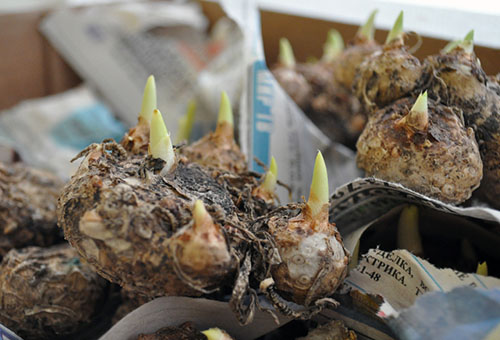
Disembarkation rules
Planting callas is carried out exclusively in the spring, in early May, when the threat of frost becomes minimal. The procedure requires preliminary preparation of the site itself and plant tubers. Planting material before being placed in the ground for 30 minutes is kept in a solution of potassium permanganate. Then the tubers are carefully examined. If areas with signs of rot or other diseases are found on them, they are carefully removed with a sharp knife, leaving only intact tissues. Cut points are treated with green paint. This stage cannot be skipped, since the cultivation of callas in the open field will be successful only when using healthy planting material.
The soil on the site is enriched by scattering complex mineral preparations over its surface (at a dosage of 30–40 g per 1 m²) and digging. Tubers are planted in holes 5–10 cm deep. If a rhizomatous variety of a flower is chosen, the pits are made even smaller, sprinkling the rhizomes quite a bit with soil. If planted too deep, they will almost certainly rot. For full development, callas will need a lot of space, so an interval of 30–40 cm is left between plants. Putting the tubers in the soil, they are sprinkled with a nutrient substrate. You can't push them into the ground. Planting ends with intensive watering.
A typical mistake of inexperienced gardeners is to expect fast shoots from calla lilies. You should not be upset, and even more so try to dig up a tuber to check its condition if the sprouts do not hatch for a long time. Having decided to grow a crop, you need to be patient. Its seedlings appear only when the underground part of the flower is fully formed. This period can be from 2 weeks to a month.
Caring for callas placed in the ground involves refusing to water for the first 14 days. The tubers should have enough moisture that they received during planting.
You can make it easier for the plant to take root in the open field by preparing it for changing conditions. To this end, at the end of March, its tubers are planted in small pots. It is allowed to move the procedure to the beginning of April, but not later. You don’t need to deepen them much, it’s enough to dig in 2 cm. It is better to plant flowers in a substrate specially purchased from the store, but you can also use ordinary soil, after calcining it in the oven for 40 minutes. Further care for callas includes regular watering (1 time in 3-4 days). Before moving to a flower bed, young plants are hardened for a week, opening a window for a short time. You need to plant them in the ground with an earthen clod so as not to damage the root system.
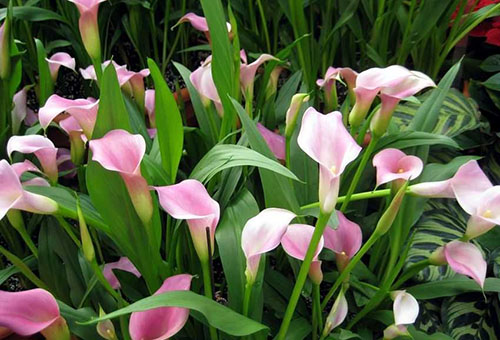
Agrotechnics calla lilies
In the summer, caring for callas in the garden is easy. Flowers will require special attention only in preparation for winter. Until autumn, they only need watering, weeding and loosening the soil. Regular and correct implementation of these simple procedures is a guarantee that the cultivation of noble calla lilies on the site will lead to its normal development, involving long and lush flowering.
Watering culture needs moderate, but frequent. It is impossible to overdo it with it, otherwise the risk of destroying the plants is high. But the soil should not dry out either. They begin to moisten it regularly when the flowers release the first leaves. The amount of moisture introduced also depends on weather conditions. If the summer turned out to be hot and dry, callas are watered more abundantly. When the days are not hot, and there is enough natural precipitation, the soil in the flower bed is moistened 2 times a week. Watering is always completed by lightly loosening the topsoil.
If, when planting plants, complex nutrient compositions were introduced into the ground, then further care in the form of additional dressings will not be needed for callas. These flowers thrive best in acidic soil. If the soil on the site does not meet this requirement, it is watered with a weak aqueous solution of citric acid or vinegar (1 tablespoon of the drug per 1 bucket of water). It is not necessary to carry out the procedure often, 2-3 times per season is enough. Calla lilies are not capricious, but they will be grateful if the soil around them is dug up, having previously scattered dry needles over it. Such care will help create an optimal acidic environment for plants. Its undoubted plus is that it is formed naturally ˗ as a result of the processing of needles by worms.
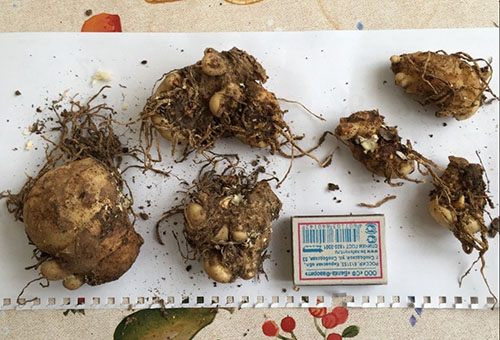
Preparing for winter
Even in the southern regions, our winters are too harsh for callas, so autumn care for a plant involves its extraction from the ground. After the flowering period ends, the leaves of the tuberous varieties of the culture begin to turn yellow and gradually dry out. If this happened, then it is time to dig them out. The procedure is usually carried out in the third week of September, being careful, since calla tubers are easily damaged. You can postpone it until the beginning and even the middle of October, weather permitting. The main thing is to have time before the first frosts.
The tubers are carefully cleaned from the soil, washed thoroughly under running water and, after 30 minutes in a solution of potassium permanganate and washed again, put to dry in a dark, cool and well-ventilated place where the temperature does not rise above 5-10˚ C. The flowers are stored there for 2 weeks. Such care is necessary so that the nutrients accumulated in the leaves of the plant pass into the tubers. At the end of this period, withered aerial parts are easily removed, and the tubers are laid out in perforated paper bags. The optimum temperature in winter for them is 5-7˚ C. Vegetable boxes in a regular refrigerator will provide it.
Storage of callas is also possible in boxes, but in this case, each tuber must be wrapped in several layers of newsprint.
Rhizome varieties of a flower, after being removed from the ground, together with an earthy clod, it is advisable to keep in a cool place, occasionally watering moderately. If this is not possible, then another method will do. The rhizomes need to be dried a little and the leaves cut off. The rules for their storage are identical to the rules for storing tubers. But you can’t leave both of them unattended for the whole winter, they need some care.
It is necessary to monitor their condition by inspecting future planting material every week. If the temperature is too high for them, the tubers and rhizomes will begin to dry and shrivel. Too much moisture will cause them to rot. Having found the first signs of awakening of the kidneys, the flowers can be planted in a pot, and then in a flower bed, following the rules described above. 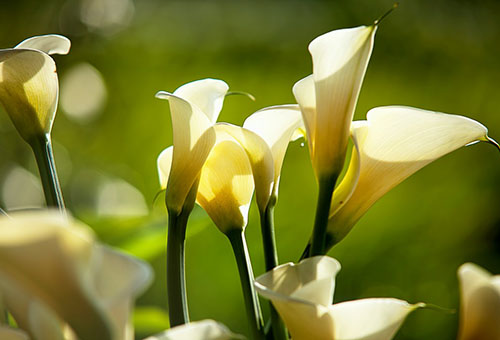
Garden callas ˗ amazing plants. symbolizing best qualities: nobility, dignity, pride, purity, ˗ they will become real queens in the flower bed. Their majestic beauty will attract admiring glances for a long time, and their gentle sensual aroma will take you to the atmosphere of oriental fairy tales. They are truly versatile, looking equally good in the front garden, in a pot on the windowsill and cut in a vase.
Do not be afraid of the southern origin of callas. For all their exoticism, they are very unpretentious. Caring for them is incredibly simple, which distinguishes them from many garden plants and makes the favorites of most flower growers. One has only to ensure that callas land in the right place, water them regularly and loosen the soil in the flower bed, and they will give the world all their splendor. Try growing this elegant flower in your backyard and it will enchant you!
- decrease in the body's immune defenses
- drowsiness
- frequent fatigue
- depression
- headaches, as well as various pains and spasms in the internal organs
If you feel frequent ailments, you just need to cleanse the body. How to do it
Callas belong to perennials. They belong to the large Aroid or Aronnikov family. Their homeland is South America, Africa, Nigeria, Tanzania.
In total, eight species of calla lilies are known, but only three are grown as a cultivated plant. But thanks to the work of breeders, a huge number of varieties and decorative forms were obtained on their basis, which are grown with great success at home, both as indoor flowers and as street flowers.
Description of the main types and varieties of callas
The following species are grown at home:
- Ethiopian calla, a rhizomatous plant with tall stems and peduncles, their height is a meter or more. This species is represented by numerous varieties, the most popular of them are Nicolai, Pearl, Green Goddess, Schone Zweibruckerin;
- Calla Remann is a tuberous deciduous plant. Popular gardening varieties - Chameleon, Evening, Indian Summer;
- Calla Eliotta is a beautiful species with unusual heart-shaped leaves. The height of the plant does not exceed fifty centimeters. The most popular decorative forms are the Yellow Corner, Vermeer, Black-Eyed Beauty.
In the people, calla lilies are often called callas. Growing a plant in a garden in the country is not at all difficult if you follow the basic rules for planting and caring for them.
It is important to be extremely careful when working with this plant, since callas are poisonous plants.
Landing
![]() Garden callas are very popular with gardeners. No matter what variety of flowers grows in the flower beds, they give the garden a sophisticated look, thanks to the high decorative qualities of the leaves and flowers.
Garden callas are very popular with gardeners. No matter what variety of flowers grows in the flower beds, they give the garden a sophisticated look, thanks to the high decorative qualities of the leaves and flowers.
Growing callas in the garden requires certain rules. This is first of all:
- spacious flower beds;
- fertile and light soils;
- lighting - at noon, flowers should be naturally protected from direct sunlight;
- the ideal soil for callas is acidic, in extreme cases, slightly acidic;
- flower beds before planting must be drained to remove excess moisture.
You can grow callas in the garden in the following ways:
- preliminary germination of plant tubers in flowerpots, followed by planting in flower beds;
- planting tubers directly in open ground.
Note that regardless of the method of planting callas, flower beds in the garden should be prepared in advance. First of all, they are dug up, and the soil is mixed with peat, river sand and last year's rotted leaves in equal quantities. It is also recommended to apply complex mineral fertilizer.
And now a few words about landing methods.
Germination of calla tubers in pots and planting them in flower beds. Before planting, the tubers should be properly prepared. They must first be "awakened" by placing them in a solution of potassium permanganate for thirty minutes, then inspect and if there are damages, then carefully remove them with a sharp garden knife, and treat the cut points with brilliant green. Planting pots are also prepared:
- they make holes for water drainage;
- lay a drainage layer of small stones and sand.
The soil is also prepared in advance. You can buy a ready-made substrate in a flower shop or prepare it yourself (the composition is described above), only before planting it should be pierced in the oven for forty minutes at a temperature of two hundred and forty degrees.
Tubers are planted in pots for germination at the end of March. Do not deepen them much into the soil, a maximum of two centimeters. After planting, the tubers need care. It is necessary to monitor the soil moisture, it should not dry out, but the water in the pot should not stagnate. The optimal amount of watering is twice a week.
In open ground, grown calla flowers can be planted in mid-May. Until this time, they must be hardened. At the beginning, young plants are left near the open window for several minutes, gradually increasing the time, then they are taken out to the balcony or street for an hour or two.
Garden calla flowers are planted in open ground carefully, together with an earthen clod, so as not to damage the root system.
Planting callas directly in open ground. Calla tubers are planted in open ground in early May. Also, as with pre-germination, they are kept in a solution of potassium permanganate and inspected for damage.
Before planting, prepare flower beds (as described a little above) and fertilize the soil. Tubers are planted at a distance of at least thirty centimeters from each other and to a depth of ten centimeters in moist soil.
Calla lilies begin to water only when their leaves appear on the surface of the soil.
Gardeners, for the most part, prefer the second method of planting tubers. It is less laborious, although it should be noted that the garden calla, which was previously grown in room conditions, begins to bloom much earlier.
After landing on the flower beds, it is important to organize proper care behind the plant.
Care
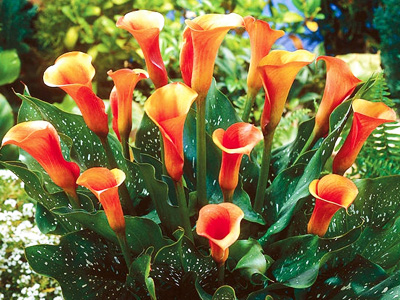 Caring for callas is not at all difficult. It is necessary to regularly perform simple actions:
Caring for callas is not at all difficult. It is necessary to regularly perform simple actions:
- water;
- fertilize;
- loosen the ground and remove weeds;
- ensure the safety of the tubers.
Care for callas in the garden must be consistent. After watering, and they are carried out no more than twice a week (in summer), less often in spring, and by autumn they completely stop when the soil around the flowers dries. She needs to be loosened. Thus, air exchange will be carried out and weeds will be removed.
Garden callas are rarely fed. If their planting was carried out in compliance with all the rules of agricultural technology. Then it can not be carried out at all, but if the plants are weak, then they should be fed with special fertilizers for garden flowering plants. Dosage strictly according to the instructions.
Since callas love acidic soil, you can additionally acidify it with citric acid. You need to take one tablespoon of the powder and dilute it in ten liters of water. Then gently pour the solution over the bushes.
When the callas fade, they completely stop watering. Gradually, the ground part of the plant will wither. It is cut, and tubers are dug up in late autumn. They are cleaned of earth and left for several days in a drying room, after which they are wrapped in several layers of newsprint and put away in a cool, dry and dark place until spring.
As you can see, planting and care in the open field for data flowering plant is not something complicated. Strictly following the recommendations of experienced gardeners, you can grow chic flower beds of blooming callas with an extraordinary aroma.
reproduction
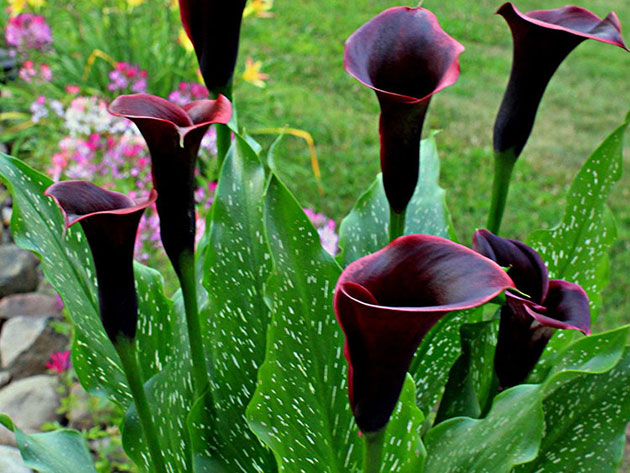 Callas reproduce in the following ways:
Callas reproduce in the following ways:
- dividing the bush;
- tubers;
- seeds.
Reproduction by dividing the bush can only be applied to rhizomatous calla species, which include Ethiopian calla varieties.
Tuberous species reproduce only in two other ways.
Tuberous reproduction. Calla is a plant that during the growing season actively increases the root mass, consisting of several tubers. Therefore, it is easiest to propagate callas in this way. In autumn, after the ground part of the flowers dies off, the tubers are dug up and sent for storage, and in the spring they are planted again in the ground. Thus, from one bulb planted in spring, several can be obtained by autumn. The technique for germinating bulbs and planting them in open ground is described above.
Reproduction by seeds. This method is laborious and therefore rarely used at home. But it is quite possible to grow calla lilies from seeds, since you can get seeds at any flower shop or collect them yourself, and the plant completely retains all maternal characteristics.
The process itself looks like this:
- germination of seeds - they are laid out on a damp paper towel and covered with the second part of it, then the seeds are placed in a cool and dark place for several days. During this time, the paper should remain moist. Then the seeds are examined, those that have hatched and need to be sown, the rest should be thrown away, since they are not suitable;
- sowing seeds is carried out in special planting boxes in nutritious and light soil (you can buy a special substrate for growing seedlings in a flower shop). Seeds after sowing are lightly sprinkled with earth. Moisten the soil with a spray gun;
- planting seedlings in the ground. After the seeds germinate, a pick is carried out, weak bushes are transplanted into other pots, and strong ones are grown. They are watered, hardened, and with the onset of heat, in May, they are planted in open ground in flower beds in the garden.